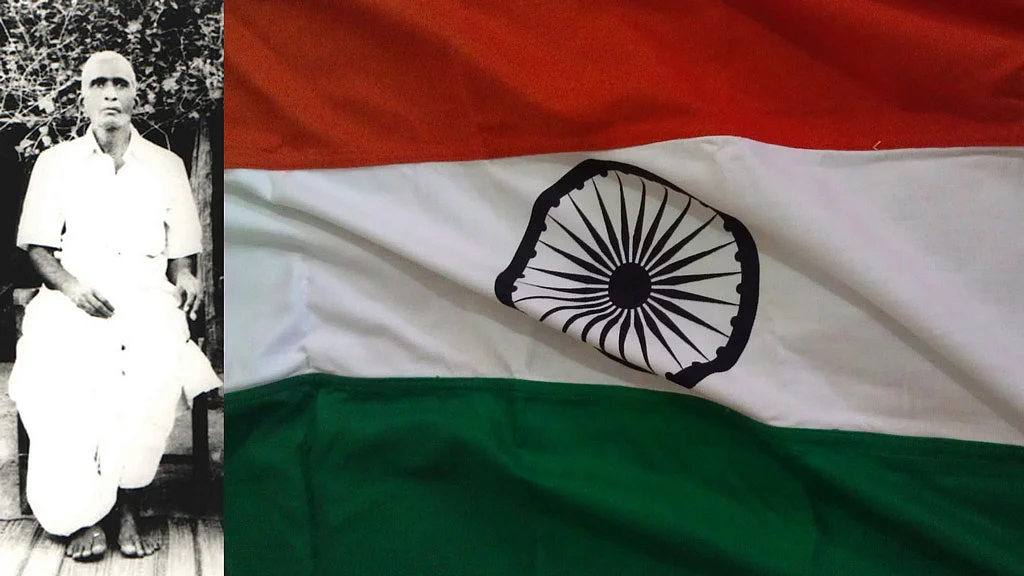Unsung Hero: Man Who Designed the National Flag Died in Penury
Man who designed the national flag died in penury, we look back at life of Pingali Venkaiah

advertisement
Pingali Venkaiah shot to fame after an article by Mahatma Gandhi in his newspaper, Young India, praised his hard work in designing India’s National Flag. Venkaiah was thereafter famous as ‘Jhanda Venkaiah’. On his 140th birthday, read the story from The Quint’s archives of the man who gave India its National Flag – but died in destitution.
Controversies continue to bog the actual history of the Indian National Flag. The Tiranga Jhanda as we see it today was a result of hard work and efforts made by a freedom fighter from Andhra, Pingali Venkaiah about whose life and times, very less is known and documented.
Venkaiah was born on 2 August, 1878 in Peddakallepalli village of Krishna district in Andhra Pradesh to Hanumantha Rayudu and Venkatarathnamma. He was their first child among half a dozen others.
Inspired by Subhash Chandra Bose’s call for an Indian Army, Venkaiah left for Bombay when he was 19 to join the military services. After training at the academy, he was sent on duty to Africa where he participated in the Boer War (1899-1902). It was during his stay in Africa that he first met Mahatma Gandhi and came under the influence of his ideology. After his return from Africa, he became a member of the secret revolutionary units fighting against the British Raj and spent time in Eluru.
The 1906, the 22nd session of the Indian National Congress took place in Calcutta, presided by Dadabhai Naroji. Four famous resolutions of Swadeshi, Boycott, National Education and Swaraj were passed in this session. Venkaiah was present and took inspiration from this in his own style. Seeing his earlier work, a highly impressed Congress appointed him as a member of the executive meeting. In that meeting his patriotic sentiments were deeply hurt watching the Union Jack being hoisted. He decided he would do something about it.
Back home in Eluru, he worked hard and developed an indigenous hybrid variety of cottonseeds. Importing the Cambodian variety from America and mixing them with Indian seeds, he created his own type. He acquired a piece of land in the nearby Chellapalli village and planted these seeds. A fine variety of cotton grew from these, which came to the notice of the local British officers during an agricultural exhibition in 1909. The Royal Agricultural Society of London offered him an honorary membership. He became famous as ‘Patti (cotton) Venkaiah’ to everyone around.
‘Jhanda Venkaiah’
In 1916 he published a book titled ‘A National Flag for India’ which carried thirty designs of the flag. Between 1918 and 1921, in every session of the Congress, Venkaiah raised the issue of having an own flag.
On his visit to Vijayawada in April 1921 for a meeting of Indian National Congress, Venkaiah met Mahatma once again and showed him his publication with the various designs of the flag. This time Gandhi showed additional interest and asked him to make a fresh design that would be inspiring for every time and generation. Overnight Venkaiah designed the flag, which was formally approved by Gandhi in the National Congress Conference. Expressing his views on Venkaiah’s hard work in an article titled ‘Our National Flag’ in Gandhi’s own paper ‘Young India’, he wrote:
We should be prepared to sacrifice our lives for the sake of our National Flag. Pingali Venkaiah who is working in Andhra National College Machilipatnam, has published a book, describing the flags of the countries and has designed many models for our own National Flag. I appreciate his hard struggle.
—Gandhi in Young India
This shot Venkaiah to fame overnight and he was called ‘Jhanda Venkaiah’.
But, his last days were spent in utter penury. Before he breathed his last, he wrote his final wish in his will which was that his body had to be covered with the tri-color he had designed. He instructed that it be removed after his body was placed on the pyre and later hung to a tree branch. When he passed away on July 4th 1963, his will was executed and the tri-colour fluttering on the tree branch was a witness to his soul soaring into the heavens.
Late Recognition
Venkaiah was forgotten for a long time. He received no awards for his contribution to India’s freedom struggle.
It was during the tenure of Prime Minister Lal Bahadur Shastry that his memory was resurrected on a trip to Vijaywada. During the Chief Ministership of N T Rama Rao, a statue of Pingali Venkaiah was installed, along with thirty-three famous Telugu personalities on the Tank Bund that connects the twin cities of Hyderabad and Secundrabad over the Hussain Sagar Lake. A postage stamp and a First Day cover were released in his honour in 2009.
A great intellectual of his times, a freedom fighter and as the designer of India’s National Flag, he will always be rememberd as ‘Jhanda Venkaiah’, every Independence Day and every occasion the National Flag is hoisted.
(Written by an award-winning writer, Vijay Sai, this piece originally featured on The News Minute. The article has been edited for length. Read here the complete article.)